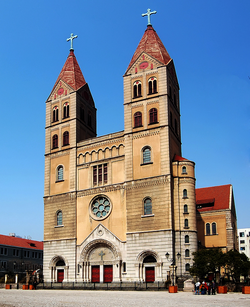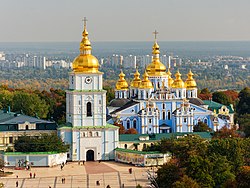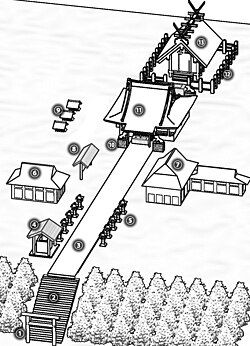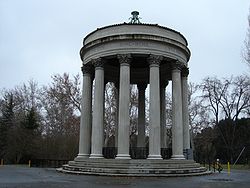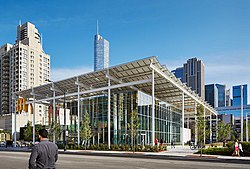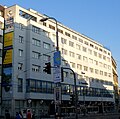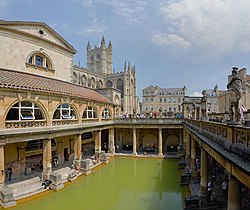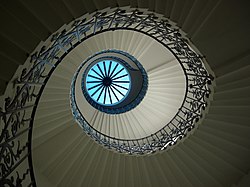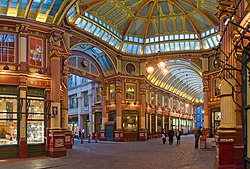
Back بوابة:عمارة Arabic Portal:Memarlıq Azerbaijani Партал:Архітэктура Byelorussian প্রবেশদ্বার:স্থাপত্য Bengali/Bangla Portal:Arquitectura Catalan Ganghaan:Arkitektura CEB دەروازە:نژیاروانی CKB Portál:Architektura a stavebnictví Czech Portal:Architektur und Bauwesen German Portal:Arquitectura Spanish
The Architecture Portal

Architecture is the art and technique of designing and building, as distinguished from the skills associated with construction. It is both the process and the product of sketching, conceiving, planning, designing, and constructing buildings or other structures. The term comes from Latin architectura; from Ancient Greek ἀρχιτέκτων (arkhitéktōn) 'architect'; from ἀρχι- (arkhi-) 'chief' and τέκτων (téktōn) 'creator'. Architectural works, in the material form of buildings, are often perceived as cultural symbols and as works of art. Historical civilizations are often identified with their surviving architectural achievements.
Architecture began as rural, oral vernacular architecture that developed from trial and error to successful replication. Ancient urban architecture was preoccupied with building religious structures and buildings symbolizing the political power of rulers until Greek and Roman architecture shifted focus to civic virtues. Indian and Chinese architecture influenced forms all over Asia and Buddhist architecture in particular took diverse local flavors. During the Middle Ages, pan-European styles of Romanesque and Gothic cathedrals and abbeys emerged while the Renaissance favored Classical forms implemented by architects known by name. Later, the roles of architects and engineers became separated.
Modern architecture began after World War I as an avant-garde movement that sought to develop a completely new style appropriate for a new post-war social and economic order focused on meeting the needs of the middle and working classes. Emphasis was put on modern techniques, materials, and simplified geometric forms, paving the way for high-rise superstructures. Many architects became disillusioned with modernism which they perceived as ahistorical and anti-aesthetic, and postmodern and contemporary architecture developed. Over the years, the field of architectural construction has branched out to include everything from ship design to interior decorating. (Full article...)
Selected article –
The World Trade Center station is a terminal station on the PATH system, within the World Trade Center complex in the Financial District of Manhattan, New York City. It is served by the Newark–World Trade Center line at all times, as well as by the Hoboken–World Trade Center line on weekdays, and is the eastern terminus of both.
The World Trade Center station is near the site of the Hudson and Manhattan Railroad's (H&M) Hudson Terminal, which opened in 1909. The Port Authority of New York and New Jersey bought the bankrupt H&M system in 1961, rebranded it as PATH, and redeveloped Hudson Terminal as part of the World Trade Center. The World Trade Center station opened on July 6, 1971, as a replacement for Hudson Terminal, which was closed and demolished as part of the construction of the World Trade Center. Following the September 11 attacks, a temporary PATH station opened in 2003 while the World Trade Center complex was being rebuilt. Work on a permanent station building commenced in 2008. The main station house, the Oculus, opened on March 3, 2016, and the terminal was renamed the World Trade Center Transportation Hub, or "World Trade Center" for short. (Full article...)
General images –
Did you know (auto-generated) -

- ... that the Grain Belt Brewery was built with four distinct architectural sections, in homage to the four companies that combined to form it?
- ... that Indian philanthropist and business executive T. Mohandas Pai has been called the "architect of modern Manipal"?
- ... that Albert Bumgardner's design for an architectural press office was highly publicized in the architectural press?
- ... that Härnösand Residence is one of the earliest examples of Neoclassical architecture in Sweden?
- ... that 81 and 101 Willoughby Street were described as being one city block apart physically but "eons apart in their architecture"?
- ... that Wing Sam Chinn combined Chinese and Beaux-Arts architecture in his design for a building in Seattle?
Related portals
Major topics
- Basic topics Architect • List of architects • Architecture • List of architecture firms • Style • List of buildings • New article announcements • more....
- Architectural history Timeline of architectural styles • Ancient Egyptian • Harappan • Inca • Mayan • Persian • Sumerian • Ancient Greek • Roman • Byzantine • Romanesque • Moorish • Gothic • Renaissance • Mannerism • Baroque • Ottoman • Palladian • Neoclassicism • Revival • Jugendstil • Art Deco • Modern • Postmodern • New Classical • more....
- Architectural theory Critical regionalism • Postmodernism • Deconstructivism • Modernism • Islamic • more....
- Architecture of the world Denmark • Germany • India • Madagascar • Norway • Russia • United Kingdom • United States • more....
- Awards Aga Khan Award • Driehaus Architecture Prize • International Architecture Awards • Pritzker Architecture Prize • more....
- Building science Architectural engineering • Earthquake engineering • Green building • Structural engineering • Acoustical engineering • Building defects • more....
- Construction Trades • Materials science • Project management • Project planning • more
- Landscape architecture Landscape architects • History • Desire lines • Energy-efficient landscaping • Greenway (landscape) • materials • Landscape design • Landscape maintenance • Landscape planning • Natural landscaping • Site planning • more....
- Law Contract law • Property law • Employment law • Land law • Tort • Equity
- Economics of Architecture Cost management • Quantity surveyor • Critical path analysis • Elemental cost planning • Cost–benefit analysis
- Planning and Urban design Topics • Zoning • Growth management • Land-use planning • New Urbanism • more....
- Architecture museums Shchusev Museum of Architecture • Museum of Finnish Architecture • German Architecture Museum
- By Year: 2015 in architecture • 2014 in architecture • 2013 in architecture • 2012 in architecture • 2011 in architecture • more....
- Vernacular architecture Timber framing • Thatching • Vernacular architecture of the Carpathians • Indian vernacular architecture • Vernacular architecture of Indonesia • Vernacular architecture in Norway • Open-air museum • Architecture of Samoa • Sasak architecture • Zakopane Style
Recognized content
Featured lists
|
|---|
|
Featured lists |
Featured pictures selections
| |||||||||||||||||||||||||||||||
|---|---|---|---|---|---|---|---|---|---|---|---|---|---|---|---|---|---|---|---|---|---|---|---|---|---|---|---|---|---|---|---|
|
|
Major subcategories
| Architects | Architecture | Architectural elements | Architectural history | Buildings & structures |

|

|

|

| |
| Architecture by country | Construction | Landscape architecture | Structural engineering | Urban planning |
All categories
Things you can do
WikiProject Architecture

- Join the WikiProject.
- Improve: articles listed at Architecture pages needing attention
- Expand: stubs - Category:Architecture stubs - Category:Architect stubs - Category:Building and structure stubs
- Request an article: about a topic in architecture.
- Featured article candidates, Good article nominees, Articles for deletion, Requested moves
Associated Wikimedia
The following Wikimedia Foundation sister projects provide more on this subject:
-
Commons
Free media repository -
Wikibooks
Free textbooks and manuals -
Wikidata
Free knowledge base -
Wikinews
Free-content news -
Wikiquote
Collection of quotations -
Wikisource
Free-content library -
Wikispecies
Directory of species -
Wikiversity
Free learning tools -
Wikivoyage
Free travel guide -
Wiktionary
Dictionary and thesaurus
© MMXXIII Rich X Search. We shall prevail. All rights reserved. Rich X Search











